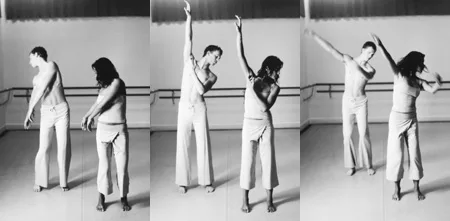Mooch around your garden before breakfast and see where it’s coldest, where frost has gathered, or where there seems to be a sunny, sheltered patch. Most gardens have these “microclimates” – cold spots where bulbs may thrive, warm spots where heat-lovers will thrive.
Warm yourself up with some heavy work in the garden – dig a new bed for spring planting, or good big holes for shrubs.
Use plastic tree guards to shelter young plants from cold winds – even recycled bubble-wrap can make a good tree guard.
Move any shrubs that are in the wrong spot.
Check that dahlia tubers are well covered with soil – big tubers can break through the surface and will rot.
Have your lawn mower serviced – don’t wait until spring to find it won’t start!
Keep pruning deciduous trees and shrubs.
This exercise gently releases and mobilises the spine.
Align your bones in the standing position.
Soften the knees and swing the arms diagonally across the body with fingers dropping towards the floor.
Lift your arms up to the ceiling extending the legs and begin to turn your head to the other side.
Soften the knees and swing the arms diagonally down across the body to begin making ‘figure eight’ patterns in the air on the other side.
Keep movements loose and relaxed and feel the weight of the bones as they fall and swing. Experiment with your natural breath to assist in finding a rhythm for this exercise.

copyright: The Australian Ballet 2005
Extracted from Bodywise, discover a deeper connection with your body; ABC Books; rrp: $34.95; fully illustrated. Available from all good bookstores.
Bodywise is written by staff at The Australian Ballet. In 2005 The Australian Ballet is performing throughout Australia and internationally. Visit The Australian Ballet’s website, www.australianballet.com.au for details.
Pain and tension are enemies of good movement patterning and smooth coordination and you have to become aware of their effect on the body before you can fully overcome poor movement habits. Poor alignment causes tension and tightness. Muscle imbalances can cause aching in the lower back or tightness in the shoulders and neck. Unfortunately, holding tension in certain parts of your body can become habitual and unconscious. Often we tense up because of stress but if we don’t learn to let go then our bodies never fully relax and return to a state of ease.
As you journey through the bones, observe where you tend to hold tension. Perhaps you grip your buttocks or pull your knees up tight or clench your jaw. Quietly let go and feel the muscles soften. When you perform the exercises be aware of tension creeping in. As you work on one part of the body, make sure that you are not gripping elsewhere. It is counter-productive to hold yourself tightly in an effort to ‘work harder’. This disrupts holistic balance and coordination and interferes with sensitivity to fine adjustments in a movement – not to mention making the exercises much less enjoyable to do.
Unlearning tension can be a difficult process, in the same way that it takes time and persistence to retrain your movement patterns. Nevertheless a release technique can be as simple as becoming aware of your breathing. You can often release tension from your jaw, neck and shoulders simply by breathing out and this is a useful thing to remember throughout the day.
Exercise itself can help you relax. As you concentrate fully on your physical self, your mind calms down and tensions from everyday life recede. Your session should leave you feeling refreshed, deeply satisfied and returned to yourself.
copyright: The Australian Ballet 2005
Extracted from Bodywise, discover a deeper connection with your body; ABC Books; rrp: $34.95; fully illustrated. Available from all good bookstores.
Bodywise is written by staff at The Australian Ballet. In 2005 The Australian Ballet is performing throughout Australia and internationally. Visit The Australian Ballet’s website, www.australianballet.com.au for details.
Question:
What sort of hairstyle would suit a square shaped face and chin?
Kay, via email.
Answer:
A good cut that suits your face shape is important to flatter your features. For a square shaped face you should choose any style with an off-centre parting, graduated layers or soft curls.
However, if you have a long, heart-shaped or round face here are some tips in choosing a style:
Long face: A hairstyle with a fringe will disguise a long forehead or chin. A shoulder-length style will add volume and broaden the face.
Heart-shaped face: Try a layered bob with extra volume, which sits outwards and counteracts the narrowing of the face at the chin.
Round face: Soft, feathery cuts with length and layers can slim down a fuller face.
The AWW Beauty Team
Question
Is there a secret to making fragrance last longer?
Janet, via email.
Answer
The secret to making fragrance last longer is layering. Build up layers of scent on the skin by using different forms of the same fragrance – perfumed soap, bath oil or gel, body lotion or cream, dusting powder and eau de toilette. Each reinforces the impact of the other to quadruple the life of your favourite scent.
Layering, or ‘fragrance dressing’ as it’s sometimes called, is also a clever way to wear a fragrance that’s too overpowering for daytime use.
The AWW Beauty Team
Question
What’s the difference between a moisturiser and a serum? Should I be using both?
Sally, via email.
Answer
Moisturisers hydrate the upper layers of the skin and generally come in a cream form. By comparison, a serum can deliver potent ingredients which repair and restore long-term changes in the skin through a lightweight, gel-like formulation that can penetrate into the skin’s dermal layers.
A serum should be applied before the moisturiser in your daily beauty routine and while it’s not essential, its reparative properties provide much desired anti-aging benefits.
The AWW Beauty Team
This exercise gently releases and mobilises the spine.
Align your bones in the standing position.
Soften the knees and swing the arms diagonally across the body with fingers dropping towards the floor.
Lift your arms up to the ceiling extending the legs and begin to turn your head to the other side.
Soften the knees and swing the arms diagonally down across the body to begin making ‘figure eight’ patterns in the air on the other side.
Keep movements loose and relaxed and feel the weight of the bones as they fall and swing. Experiment with your natural breath to assist in finding a rhythm for this exercise.

copyright: The Australian Ballet 2005
Extracted from Bodywise, discover a deeper connection with your body; ABC Books; rrp: $34.95; fully illustrated. Available from all good bookstores.
Bodywise is written by staff at The Australian Ballet. In 2005 The Australian Ballet is performing throughout Australia and internationally. Visit The Australian Ballet’s website, www.australianballet.com.au for details.
Pain and tension are enemies of good movement patterning and smooth coordination and you have to become aware of their effect on the body before you can fully overcome poor movement habits. Poor alignment causes tension and tightness. Muscle imbalances can cause aching in the lower back or tightness in the shoulders and neck. Unfortunately, holding tension in certain parts of your body can become habitual and unconscious. Often we tense up because of stress but if we don’t learn to let go then our bodies never fully relax and return to a state of ease.
As you journey through the bones, observe where you tend to hold tension. Perhaps you grip your buttocks or pull your knees up tight or clench your jaw. Quietly let go and feel the muscles soften. When you perform the exercises be aware of tension creeping in. As you work on one part of the body, make sure that you are not gripping elsewhere. It is counter-productive to hold yourself tightly in an effort to ‘work harder’. This disrupts holistic balance and coordination and interferes with sensitivity to fine adjustments in a movement – not to mention making the exercises much less enjoyable to do.
Unlearning tension can be a difficult process, in the same way that it takes time and persistence to retrain your movement patterns. Nevertheless a release technique can be as simple as becoming aware of your breathing. You can often release tension from your jaw, neck and shoulders simply by breathing out and this is a useful thing to remember throughout the day.
Exercise itself can help you relax. As you concentrate fully on your physical self, your mind calms down and tensions from everyday life recede. Your session should leave you feeling refreshed, deeply satisfied and returned to yourself.
copyright: The Australian Ballet 2005
Extracted from Bodywise, discover a deeper connection with your body; ABC Books; rrp: $34.95; fully illustrated. Available from all good bookstores.
Bodywise is written by staff at The Australian Ballet. In 2005 The Australian Ballet is performing throughout Australia and internationally. Visit The Australian Ballet’s website, www.australianballet.com.au for details.
If you’re fit, you can function – if not, you’ll find it difficult to get through the day. Try these ideas:
1. Use stairs, not lifts
It’s nearly always only a flight or two.
2. Do two things at once
While you’re brushing your teeth, do leg lifts or knee bends. If you have a cordless phone, stretch or walk around while you talk.
3. Play with your kids
Get out there and ride a bike or have a go on the swings. When you watch them play sport, walk up and down the sidelines.
4 .Walk wherever possible
Always put a little distance between yourself and your destination. Walk up the street to get milk. Park and then walk to the theatre, school, or office.
5. Try Eastern-style exercise
Graceful practices such as tai chi enhance physical and mental wellbeing, without you having to raise a sweat.
6. Snippets of excercise
Buy a stationary bike or mini-trampoline so you can grab small snatches of exercise time at home.
7. Dance while you dust
Housecleaning can be a great aerobic workout if you put on upbeat music while you work.
New research at the Australian Institute of Sport is focusing on the best way to test for suboptimal iron status and the findings will follow through to all people, even sports fanatics of the spectator variety. Sports scientists are honing a new, super sensitive blood test for iron status known as serum transferrin receptor.
Why is low iron a concern?
Constantly searching for ways to boost athletic performance, scientists have long been researching poor iron status and the fatigue factor, in both female and male sports people. When it comes to iron stores, fatigue can set in well before your tank runs dry and iron deficiency anaemia is diagnosed. Iron depletion can also result in increased recovery time, decreased immunity, cold like symptoms and depression.
Why are athletes at risk?
Along with being at risk of low iron intake from dietary imbalances, athletes undergoing vigorous training regimes or running sports, commonly experience increased iron losses due to foot strike haemolysis. Haemolysis, the breakdown of red blood cells and therefore iron loss, occurs at a faster rate than in sedentary people from the training stress on blood vessels when feet are constantly “striking” or in contact with hard surfaces.
Why is a sensitive test required?
Scientists have found it difficult to set “ideal” blood testing levels for the markers of iron status, as they’re most interested in detecting impaired performance when iron stores are slightly depleted, not by the time true iron deficiency anaemia has occurred. Iron depletion may be present when regular blood tests for iron are normal. Recently published data in the Clinical Journal of Sports Medicine is revealing that this new super sensitive iron test could pick up 66% of athletes with iron depletion that would have been missed with traditional blood tests.





























.jpg?resize=380%2C285)









